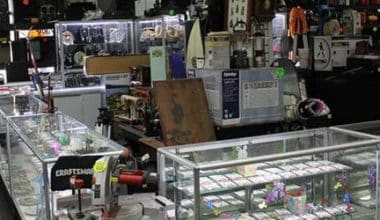Selling stuff on apps is a fantastic way to make money, whether it’s simply for some additional spending money or as a full-time side business. You can quickly get started by downloading an app and selling almost everything you can imagine, including designer handbags, secondhand smartphones, sunglasses, and even LEGOs. Read below for more information on the best apps to sell stuff locally, and study their benefits, and drawbacks.
Apps to Sell Stuff
The world is your oyster when it comes to selling stuff via an app; in other words, you have a larger audience of potential purchasers than when you conduct a yard sale or sell to a neighborhood consignment shop. Additionally, you can list a lot of items at once and get paid quickly. Gaining More from Your Funds From our list of the best banks, select a high-interest checking, savings, certificate of deposit, or investment account, and start saving right away.
The best apps to sell stuff
The top apps for selling your stuff are listed below.
#1. eBay
eBay, which was established in 1995, is currently king as one of the best apps to sell your goods. For merchants that specialize in the following fields, which eBay lists as its bestsellers, the vast internet market is a goldmine.
- Automobile attire, footwear, and accessories
- Collectibles
- Industrial and commercial
- house and yard
- Jewelry and timepieces
- Wellbeing and beauty
- products for sports
You should choose a different app if your item doesn’t fit into one of these categories.
Pros
- A large number of item categories
- Massive market of purchasers
Cons
Shipping and commission costs
#2. OfferUp
OfferUp, a Craigslist rival, was established in 2011 and has since gained popularity in the online marketplace industry. On OfferUp, you can sell just about anything, but household items like furniture and appliances often get a lot of attention. On OfferUp, you can search for and list cars as well.
Pros
- Zero listing charge
- the capacity to sell a variety of goods
Cons
The app emphasizes live transactions.
#3. Poshmark
Open a Poshmark account right away and start listing any designer purses, clothing, shoes, or accessories you’ve been hoarding. Depending on how many active listings they have on the app, Small Business Trends estimates that Poshmark vendors can make between $100 and $2,000 each month.
Pros
- The easy buying process and open pricing.
- It is able to market designer garments and accessories
Cons
Ideal for premium goods and flawless goods
#4. Facebook Market
Facebook Marketplace serves the same purpose as OfferUp: local buyers and sellers. Therefore, this app is not for those looking to cast a national or even a global net. It was introduced in 2016, and it’s a terrific place to sell expensive stuff like vehicles, furniture, and appliances. By placing advertisements, Facebook monetizes its service.
Pros
- a viable choice for larger item sales
- You can avoid paying delivery costs by selling to local customers.
Cons
A lack of buyer protection
#5. Decluttr
Decluttr, which debuted in the United States in 2014, focuses on selling used technology, such as smartphones, tablets, wearables, CDs, DVDs, and games. However, you can also sell books and LEGOs in this location.
Pros
- Easy to follow procedure
- satisfactory clientele
Cons
You might not get what you think your thing is worth because they decide the price.
#6. Mercari
Mercari, an online marketplace that originated in Japan but is now fully operating in the United States, lets customers sell anything they want, including used books and technology as well as clothing and accessories. Items that sell well on Mercari, according to Reselling Revealed, include:
- Cameras, phones, speakers, and other compact electronics.
- Systems for playing video games
- Fashionable or stylish attire
- Bags and clutches
- Sports and outdoor equipment
It’s advisable to use a different app if you are selling outside of these categories.
Pros
Minimal commission costs
Cons
- A small selection of popular item categories
- Due to scammers, you should exercise more caution.
#6. Tradesy
The best-selling brands on Tradesy, where you can find upscale clothing, are Chanel, Louis Vuitton, and Gucci. The best place to sell non-designer clothing is on eBay.
Pros
Introduces you to a large audience seeking designer goods.
Cons
- Tradesy has a very high rating from customers.
- There is a transfer fee for only high-end clothing earnings.
#7. Nextdoor
The place where neighbors can communicate and complain is Nextdoor. They go there to sell a variety of goods as well. Unload your goods at a price you decide on with no fees to customers in your neighborhood, similar to Facebook Marketplace and OfferUp.
Pros
- Introduces you to local buyers
- Simple to avoid a shipping charge.
- excellent for larger goods
Cons
- A lack of buyer protection
- Due to scammers, you should exercise more caution.
Best Apps to Sell Stuff Locally
The top apps for selling locally are listed below if you would prefer to sell to a local buyer:
#1. Craigslist App
With divisions for different locales, Craigslist is a fantastic website that was established in 1995 and serves as a classified ad website for everything from jobs to gigs to debates.
The biggest benefit of utilizing Craigslist is that it has been around for such a long time; 25 years is a long time to establish a strong following, so it already has a sizable user base.
#2. Flea Market Flipper
A free 45-minute flipping course led by Rob and Melissa Stephenson of Flea Market Flipper is one of the finest apps to start learning how to sell furniture and other goods for profit.
The course, often referred to as Flipper University, will teach you the finer skills of “picking”—how to recognize which used products are deserving of the effort of being resold for a profit. After that, you can take care of any polishing or repairs before deciding which local marketplace is best for selling your chosen flea market item for a healthy return on investment.
#3. OfferUp
It is quickly rising to the top of the list of selling apps. OfferUp bought LetGo in 2020, and the two companies have since joined their virtual markets. With the OfferUp app, you can sell anything, including cars and potted plants.
Furthermore, you’ll be conducting local and direct business with a customer. The biggest mobile marketplace for local buyers and sellers, according to the website, is another boast.
#4. 5miles
The founders of 5miles created the site to address issues they had with other online markets, such as spam, fraud, high listing costs, and perplexing browsing options. They address these issues by confirming each user’s identification and providing a gorgeous app layout.
Although it is technically a global app, its greatest drawback is that it is only useful in a few major US cities. The major ones are Tampa, Miami, Dallas, and New York.
#5. Trove
Due to its size, weight, and high shipping costs, old furniture can be difficult to sell online. Trove responded to this issue by creating an app just for it.
Only a select few of the largest US cities currently support the app: Atlanta, Austin, Boston, Charlotte, Chicago, Dallas, Detroit, Houston, Los Angeles, Miami, New York, Philadelphia, Phoenix, San Francisco, Seattle, and Washington, D.C.
#6. Chairish
Although they sell more than just chairs, Chairish is another furniture specialist. Chairish charges a 20% commission in contrast to Trove, which is free.
Instead of selling any old furniture, Chairish focuses on high-quality products, which draws customers willing to pay more as opposed to those looking for the lowest option.
#7. Carousell
Carousell is based in Singapore and currently serves only the countries of Australia, Hong Kong, Indonesia, Malaysia, New Zealand, Singapore, and Taiwan in the Australasia area. It did, however, just start operating in Canada, and it might do so shortly in the USA.
#8. Vinted
Anyone looking to organize their wardrobe may also want to think about Vinted. Jewelry and used clothing are the only things that are sold on the website. Vinted is a well-known software for buying and selling goods with 22 million users. There are no membership or listing costs. Payment is made via PayPal.
#9. Depop
Depop is mostly a clothing marketplace, but they also promote handmade, original, and vintage goods. The app’s goal is to create a community, so your contacts can see the things you buy, sell, and like. Depop only works with apps. At the moment, it only conducts business in the UK, the USA, and Italy.
#10. The Wallapop
Wallapop, which bills itself as a virtual flea market, might be the best option if you want to sell a wide range of products. The products closest to users will come first in a list of items on their app. Over 30 million people use the service.
How Can I Sell Stuff Fast?
Here is tried-and-true advice for selling stuff fast:
- Select the items to sell and the location.
- Set a reasonable price for it.
- Your item should be clean and ready.
- Take excellent photographs.
- In your description, be truthful.
- Be accessible to respond quickly to prospective purchasers.
- Consider the best time and method for listing.
- Familiarize yourself with the terminology and the norms of society.
- Beware of fraudsters and keep safe.
Where Is Best to Sell Online?
The Best online shopping platforms for your online business are listed below:
#1. Your Personal Online Shop
Zyro, a website creator
With your own eCommerce website, you have one of the best opportunities to sell online. Without an intermediary making money off of your sales, it permits conducting business directly with clients.
#2. Amazon.com’s Home Page
Amazon is the market leader among online marketplaces. It is a popular choice for business owners hoping to launch a multi-million dollar empire because it is the top site for product searches.
#3. eBay’s Main Website
Another well-liked internet marketplace is eBay. Although there are many different product categories, similar to Amazon, more people use this site to look for used goods.
#4. Etsy
the Etsy website
One of the most popular places for crafters, hobbyists, and thrift store flippers to sell their wares is Etsy. Only handcrafted goods, craft supplies, and vintage things that are at least 20 years old are accepted on this internet marketplace.
#5. Bonanza
Website: Bonanza
Although Bonanza may not be as well-known as other online selling platforms, independent business owners have begun to favor it. In fact, according to EcommerceBytes, it was the second-best market that year.
#6. eBid
Homepage of eBid
eBid is a great substitute if you’re seeking for online marketplaces like eBay. In comparison to its rivals, it mostly uses an auction pricing approach and levies lesser costs.
#7. Ruby Lane
Ruby Lane’s main page
One of the top online marketplaces for selling vintage, antique, and valuable items is Ruby Lane.
#8 Poshmark
Page of Poshmark
Consider Poshmark if you want to sell used clothes, cosmetics, and home décor items. It’s a consumer-to-consumer marketplace where people can sell their unused things to earn money. On the platform, many people have also created reseller businesses.
Conclusion
It has never been simpler to sell on apps. To avoid any last-minute shocks, make sure to read all the tiny print in the “How it works” sections when signing up for a new app. Don’t forget to take flawless images in well-lit conditions and to be as transparent and specific as you can when describing your things. No mistake can go unreported!
Related Articles
- SELLING APPS: Free & Best Selling Apps in 2023
- HOW TO SELL ON POSHMARK: EASY STEP BY STEP GUIDE
- HOW TO SELL ON FACEBOOK MARKETPLACE: Detailed Guide
- FOLLOW UP EMAIL: Complete Guide & How to Send It With No Response






